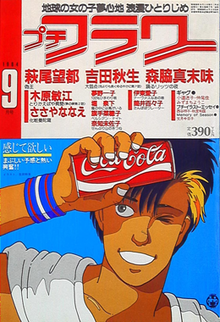 Cover of the September 1984 issue Cover of the September 1984 issue | |
| Categories | Manga (shōjo) |
|---|---|
| First issue | 1980 |
| Final issue | March 2002 |
| Company | Shogakukan |
| Country | Japan |
| Based in | Tokyo |
| Language | Japanese |
Petit Flower (プチフラワー, Puchifurawā) was a Japanese shōjo manga magazine published by Shogakukan. Founded in 1980, the magazine ceased publication in March 2002, when it was replaced by the magazine Flowers.
History
Shogakukan began publishing Petit Flower as a regular magazine in 1980, after the success of Flower Comic, a one-off special issue of the manga magazine Bessatsu Shōjo Comic. The magazine targeted a readership of girls and women in their late teens to mid 20s. The magazine was initially edited by Junya Yamamoto [ja], who was also the editor of Bessatsu Shōjo Comic; consequently, the artists published in Petit Flower typically were given limited editorial support but a significant degree of editorial freedom.
The magazine published works by several of Shogakukan's most notable female manga artists, such as Moto Hagio and Keiko Takemiya. It is credited with launching the careers of Reiko Okano and Keiko Nishi. Petit Flower folded in March 2002, and was replaced the following month with the magazine Flowers.
Serializations and one-shots
| This list is incomplete; you can help by adding missing items. (January 2021) |
- Mesh by Moto Hagio (1980–1984)
- The Visitor by Moto Hagio (1980)
- Yumemiru Wakusei by Shio Satō (1980–1984)
- Kaze to Ki no Uta by Keiko Takemiya (1981–1984)
- Yume no Ishibumi by Toshie Kihara (1982–1997)
- 4/4 by Moto Hagio (1983)
- Kawa yori mo Nagaku Yuruyaka ni by Akimi Yoshida (1983–1985)
- Fancy Dance by Reiko Okano (1984–1990)
- Hanshin: Half-God by Moto Hagio (1984)
- One Zero by Shio Satō (1984–1986)
- X+Y by Moto Hagio (1984)
- Blue Moon by Masumi Moriwaki (1985–1988)
- Marginal by Moto Hagio (1985–1987)
- Tomoi by Wakuni Akisato (1985–1986)
- Watashi o Tsuki made Tsuretette! by Keiko Takemiya (1985–1986)
- Lucky Jō-chan no Atarashii Shigoto by Fumiko Takano (1986–1987)
- Iguana Girl by Moto Hagio (1992)
- A Cruel God Reigns by Moto Hagio (1993–2001)
- Amakusa 1637 by Michiyo Akaishi (2000–2002)
Notes
- Began serialization in Sho-Comi in 1976.
- Continued serialization in Flowers.
References
- Toku 2015, p. 200.
- ^ Brient, Hervé. "Hagio Moto, une artiste au cœur du manga moderne". du9 (in French). Retrieved January 27, 2021.
- ^ Fasulo, Fausto (Fall 2019). "Keiko Nishi: Parcous de combatantes". Atom (11). Custom Publishing France: 68–69. ISSN 2552-9900.
- Toku 2015, p. 226.
Bibliography
- Toku, Masami (2015). International Perspectives on Shojo and Shojo Manga: The Influence of Girl Culture. Routledge. p. 250. ISBN 978-1-317-61075-5.
| Petit Flower | |
|---|---|
| 1980s |
|
| 1990s |
|
| 2000s |
|
| Related | |
| † Indicates titles that began or continued serialization in other magazines | |
| Shogakukan manga magazines | |||||||
|---|---|---|---|---|---|---|---|
| Kodomo | |||||||
| Shōjo | |||||||
| Josei | |||||||
| Shōnen | |||||||
| Seinen | |||||||
| Defunct |
| ||||||
This article about an anime or manga magazine is a stub. You can help Misplaced Pages by expanding it. See tips for writing articles about magazines. Further suggestions might be found on the article's talk page. |
This Japanese magazine or journal-related article is a stub. You can help Misplaced Pages by expanding it. See tips for writing articles about magazines. Further suggestions might be found on the article's talk page. |